African Savanna

African Savanna
About this Exhibit
Surrounded by many of the iconic species that live on the plains of East Africa, the African Savanna exhibit is Utah’s Hogle Zoo’s largest exhibit at 4.5 acres. It’s also the first exhibit guests will see as they enter the zoo. Don’t forget to take a ride on the Eccles Express, that travels around the African Savanna and Wild Utah exhibits.
Nearly half of Africa’s landmass is covered with savanna, which is around five million square miles of terrain. The savanna is home to the largest diversity of hoofed animals on earth and fierce predators. Now, guests don’t have to travel to Africa to experience the majesty of the savanna. Enjoy it all from the African Savanna exhibit here at Utah’s Hogle Zoo. Guests can also view our bachelor herd of Hartmann’s mountain zebras at the High Desert Oasis exhibit.
At a Glance:
- Built in 2014
- UHZ's largest exhibit space at 4.5 acres
- Contains the Grasslands, Lion Hill, Twiga Terrace, and Meerkat Manor
- Meerkat Manor was added in 2019 alongside Warthogs
- The Eccles Express train ride travels around the African Savanna and Wild Utah exhibits
African Savanna resident animals:
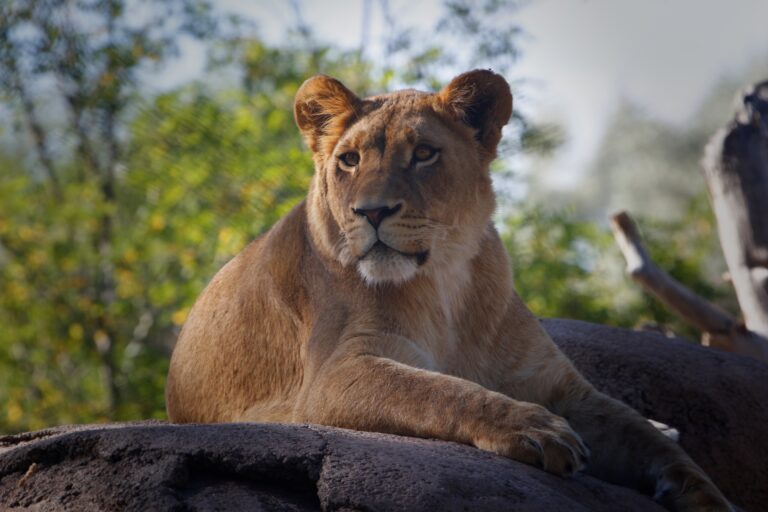
African Lion
Range:
Central and Southern Africa
Habitat:
Savannahs, lightly wooded country, bush, and open plains.
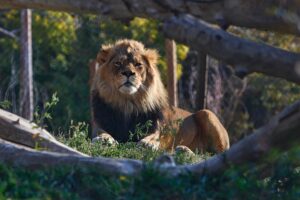
Characteristics:
Male lions weigh between 330 and 550 lbs., while female lions weigh from 265 to 395 lbs, with a head to body length of 4.6 to 6.3 feet and a tail length around three feet. The lion coat is light tawny yellow or buff with a white abdomen. The male has a mane that varies in color from light tawny to dark brown to black and is protection during a fight. Its color provides excellent camouflage in grassy plains and scrub country.
Behavior:
Lions do not normally climb trees, but lionesses and young may jump into low branches to sun themselves or to reach a cached kill. Within lion prides, there are reproductive, hierarchical, and social relationships. Females tend to form the stable population of the pride with the males drifting off by themselves or with other males from time to time. The males have the task of defending the pride from other males and defining the territory belonging to the pride. Females are responsible for hunting and care of the young. Prides may consist of 4-5 individuals, up to 30. Lions are diurnal and nocturnal, and most hunting occurs at night.
Reproduction:
Females usually become pregnant in the spring, but may come into estrus at any time during the year. After a gestation of 100-112 days, 3-4 cubs are born. The female normally leaves the pride for the birth of her cubs, and may occasionally be accompanied by another female. The young are generally weaned at 8-10 weeks and stay with their mother up to 18 months.
Interesting Facts:
Lions were once common throughout Europe and Asia with the last European lion disappearing between 80-100 A.D.
Conservation:
African Lion populations are rapidly declining due to loss of habitat, hunting and poisoning by agriculture and livestock interests. By the end of this century, it’s possible lions will only exist in parks and preserves.
The African Lion is one of Utah’s Hogle Zoo’s Big 6 species. To learn more about African Lion conservation, CLICK HERE
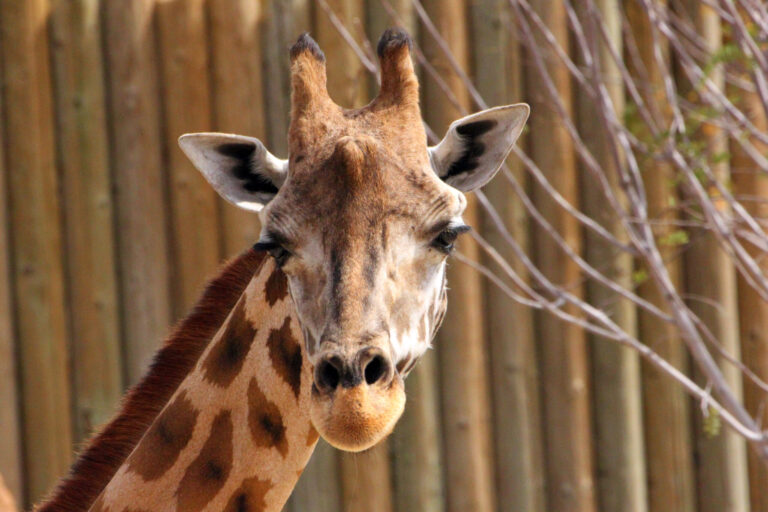
Giraffe
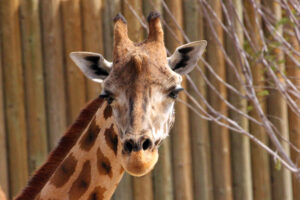
Range:
Baringo Giraffe – Northwest Kenya and Southeast Uganda. Formerly a wider distribution through Africa. They have been exterminated over most of West Africa through overshooting.
Reticulated Giraffe – South and East Kenya from Mt. Kenya and Tana River and northward into Ethiopia.
Habitat:
Dry open country, covered with bush and acacia.
Characteristics:
Adult males usually are about 17 feet tall, weighing as much as 3,000 pounds. Large males probably eat about 75 pounds of food a day. When it drinks, it can take in 10 gallons of water at one time. The pattern of spots on every giraffe is unique and is used to tell one from another.
There are two species of giraffes:
Baringo – One of the largest of giraffes, similar to reticulated – white lines are wider and neck may be blotched instead of narrowly reticulated. Legs lack any markings below the knees and hocks.
Reticulated – Considered a full species by many. Has very large rufous blotches separated by very narrow white lines (reticulations).
Behavior:
They live in herds of from 2 or 3 to 70. To defend themselves, giraffes kick with their fore legs. They have even been known to kill a lion with a kick when defending their babies.
Reproduction:
Courting behavior is relatively rare: the most common sexual behavior is urine testing, the male collects some urine of the female in his mouth or tongue. Typical gestation of 14-15 months. The female gives birth in a standing position. During its first week, a baby can grow more than one inch a day, and will be almost 10 feet tall by the time it is a year old.
The first giraffe exhibited was in Rome in 46 B.C. by Julius Caesar. It was thought to have a camel for a mother and a leopard of a father. The ancient Romans called it a “camel-leopard”. (From this, its scientific name – camelopardalis).
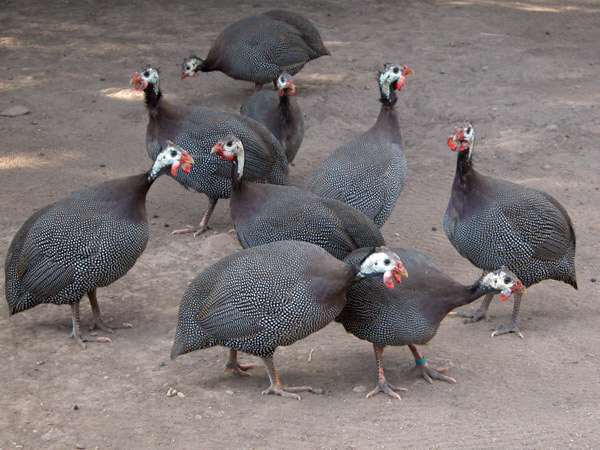
Helmeted Guinea Fowl
Range:
Most of Africa, except desert and heavy forest regions. A small population of Helmeted Guinea fowl can be found in Morocco.
Habitat:
Scrubland, savanna
Characteristics:
These birds have a wattle on each side of their beak and a horny “helmet” on top of their brightly colored head. They have a bead-like design on their feathers which consists of tiny white dots on a dark background.
Behavior:
These noisy birds usually live in large groups. In the wild there have been as many as 2,000 guinea fowl roosting together in a tree. They are capable of flight, but prefer to spend most of their time on the ground. In some places, like forests, they will roost in trees at night.
Reproduction:
The large flocks break up into smaller groups during breeding season. Females incubate 12-15 eggs for 24-30 days.
Interesting Facts:
Usually seen in large flocks, but walk through the bush in single file and imitate whatever the leader does. Helmeted guinea fowl are the original birds from which domestic guinea fowl were bred.
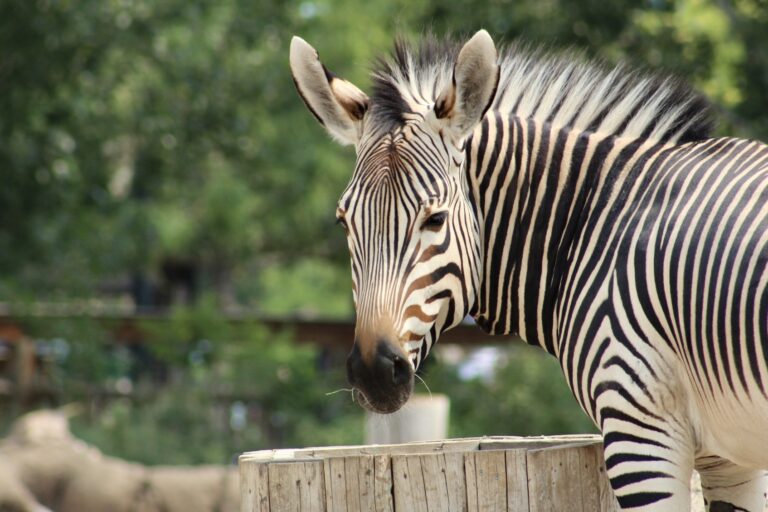
Hartmann's Mountain Zebra
Range:
Hartmann’s mountain zebras range from South West Africa into extreme southwest Angola.
Habitat:
Slopes and plateaus in mountainous areas.
Characteristics:
Unlike other zebras, the mountain zebra has a dewlap, or fold of skin, hanging from the throat. The mane is short and erect, with no forelock. The mountain zebra is a good climber and has very hard and pointed hooves compared to other zebras and horses.
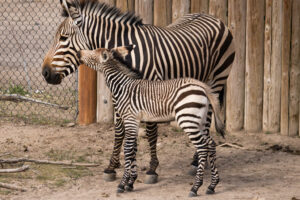
Behavior:
Mountain zebra are mainly active in the early morning and late afternoon to sunset. Grazing and resting occupy most of the daylight hours. During cold weather, they shelter in wooded areas or caves, and go to east-facing slopes to warm up in the morning sunshine.
Reproduction:
Mountain zebra form small herds of one adult stallion and 1 to 5 mares with young. Breeding herds remain stable over many years and mares usually remain in a herd for life. Gestation lasts one year, with one foal born at a time. Foals weigh about 55 pounds at birth, and are up and walking within hours. Foals are weaned at 10 months.
Interesting Facts:
Hartmann’s mountain zebras are commonly found at play. Types of play include chasing, racing, play-fighting, and challenge games. Challenge games usually consist of nose-to-nose contact followed by mutual grooming.
At high temperatures, the striped pattern of the zebra may serve as camouflage, an adaptation to the resultant “waviness” of the air. At a distance of a few hundred yards, the stripes make a zebra appear indistinct.
No two zebras are alike – each has a distinct stripe pattern, just like with human fingerprints.
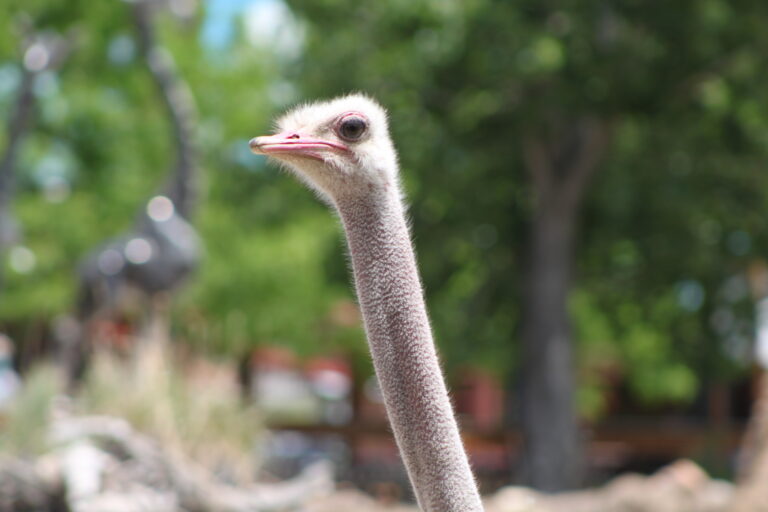
Ostrich
Habitat:
Ostriches are found in the savannas and deserts in areas with short grass, which provides food and lets them see long distances
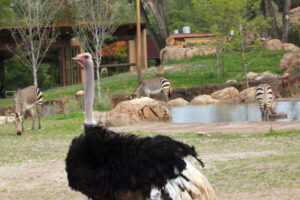
Characteristics:
Ostrich are very large birds with long necks and legs but relatively small heads. Male ostrich are larger than females and characterized by primarily black with white plumage on their tails and wings. Since they don’t fly, ostriches have lost the stiff, strong wing and tail feathers that flying birds require. Instead, ostrich feathers are loose and soft. To protect themselves, ostrich have four-inch claws on a cloven foot and can kick hard enough to kill a lion.
Behavior:
Ostriches live in a mixed society of flocks, individuals and families. These groups may range in size from five to fifty or more and peacefully co-exist; however, they stay in their individual flocks. They are often accompanied by zebras or antelopes, which kick up insects and rodents for the birds. In return, the ostriches, with their keen hearing, eyesight, and great height are able to warn other animals of danger.
Ostrich do not hide their heads in the sand to avoid danger. However, to escape danger, they will attempt to look like a rock by flattening its head and neck onto the ground. This may give the appearance from a distance that the head is buried because only the body is visible.
Reproduction:
Right before the start of the rainy season, ostrich form harems. This helps ensure that enough food will be available for the newly hatched chicks. The male puts on an elaborate courtship display that includes the male bowing and waving his feathers toward the female. Once the harem is established, the dominant male mates with all the female members of his harem but forms a pair bond only with the dominant female. Each hen lays two to eleven eggs in a shallow nest dug out by the male’s powerful legs.
Interesting Facts:
Ostriches are the world’s largest and heaviest birds and although they have wings they are unable to fly. Instead, they use their wings for balance when running, for courtship displays, for protecting their eggs and hatchlings, and for body temperature control.
An ostrich can reach a top speed of up to 45 miles per hour and can take a stride as long as 15 feet!
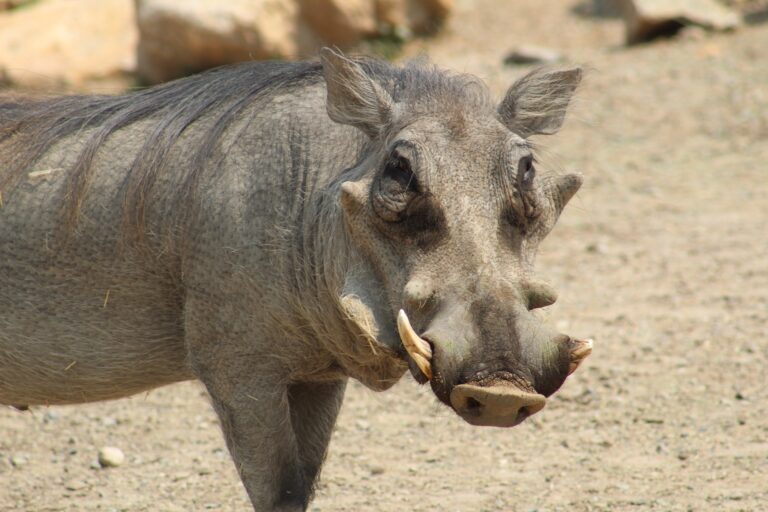
Southern Warthog
Range:
Warthogs live in sub-Saharan Africa
Habitat:
Found in savanna, scrubland and scrub-forest areas.
Characteristics:
Both male and female warthogs are distinguished by very large heads and “warts” — thick protective skin pads that appear on both sides of the head. The warty patches are primarily used to protect their faces during fights. Warthogs tend to be right or left-tusked, so the tusks on one side of the face often show more wear. The tusks grow continuously throughout their lives.
Warthogs have poor eyesight, but they have an excellent sense of hearing and smell. Their eyes are located high on the sides of their heads providing them with a wide view of the landscape as they feed.
Behavior:
A group of warthogs is a sounder and is usually made up of females, called sows, and their offspring, called piglets. Male warthogs are called boars and are less social, often traveling alone except during mating season.
Den sites are important to warthog survival. Dens provide them with both protection from the sun and insulation from cold. Sometimes, warthogs fill their dens with grasses for added warmth. In the mornings, when exiting the burrow, the warthogs burst out of their dens at top speed to get a running start on lurking predators.
Warthogs often wallow in mud holes. This behavior serves three purposes. First, they lack sweat glands, so they are able to cool their body temperature in the mud. Second, since they lack thick fur, a nice coating of mud serves as protection from sunburn and biting insects. Third, the muddy coloration helps them to blend in with the color of the mud hole.
Reproduction:
During the breeding season, males battle for the chance to mate and are observed butting heads and large upper tusks, in an attempt to attract mates. The large warts on their faces serve as shock absorbers during combat. Once the female is pregnant, gestation lasts about five and a half months. She gives birth to one to eight piglets.
Interesting Facts:
Warthogs can reach speeds of 30 miles per hour. Their speed helps them outrun predators.
Warthogs have a unique symbiotic relationship with ox peckers, yellow hornbills and other birds. They allow these birds to ride on their backs and eat insects off their bodies.
Warthogs are able to go long periods without water, as long as several months in the dry season.
Conservation:
Although warthogs are beneficial to the land by churning up the land aerating the soil and aiding plant growth as they root for food, they are often involved in human-wildlife conflicts.
They are also threatened by habitat destruction and fragmentation as well as competition with livestock for water and food. They are also hunted for bushmeat, skins and their tusks.
Exhibit Features:
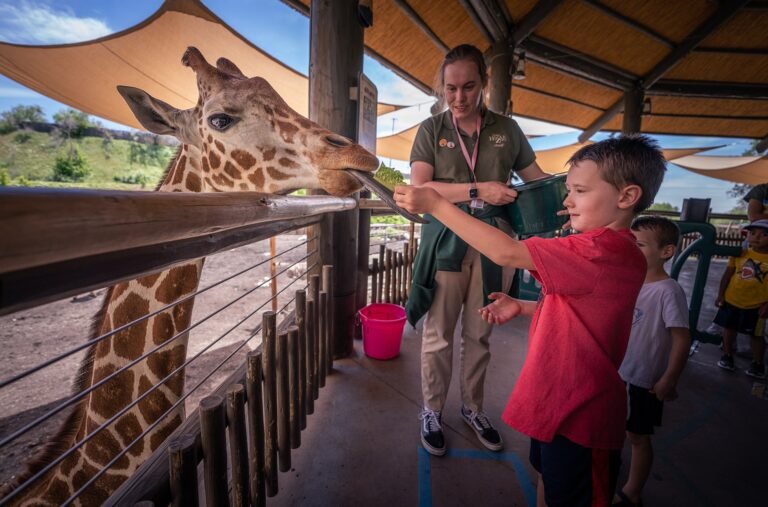
Twiga Terrace
Twiga Terrace is the primary landmark of the African Savana exhibit. Twiga is Swahili for ‘giraffe’, so during the summer, guests have the opportunity to meet and feed a giraffe. The location offers impressive open-air views of the surrounding area serving as the perfect vantage point for observing the mixed-species residents of the African Savanna at Utah’s Hogle Zoo.
James E. Hogle, Jr. Meerkat Manor
On the opposite side of the African Savanna stands Meerkat Manor, lovingly named after James E. Hogle, Jr. whose ancestors donated the land that Utah’s Hogle Zoo sits on today.
Meerkat Manor features Meerkats and some prickly African porcupine friends as well. During the summer, keepers often need guests’ help with a Meerkat bug toss. See the daily schedule on Instagram or in the entry plaza for more details.
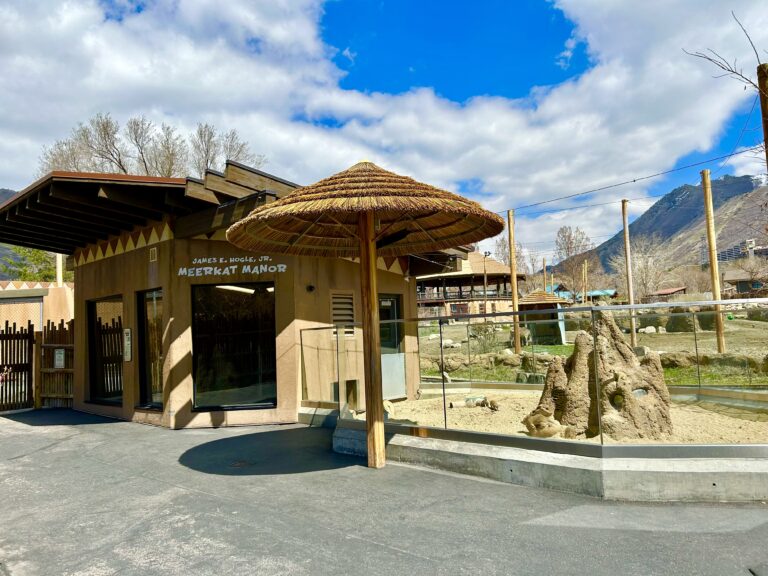
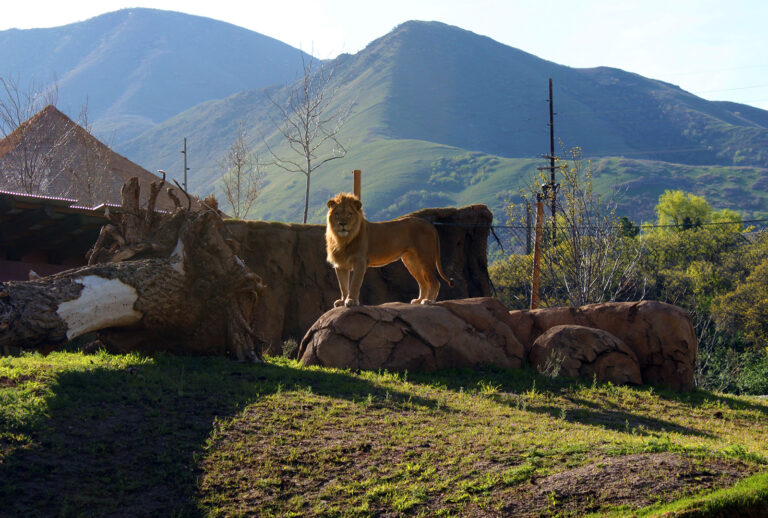
Lion Hill
Lion Hill features grottos, heated concrete, and mighty rock perches for our African lion residents. Here, floor-to-ceiling windows bring guests up close with these magnificent predators. Our lion pride consists of two male and three female lions. Guests will watch as they bask in the sun with the picturesque view of the Wasatch Mountains behind them.
